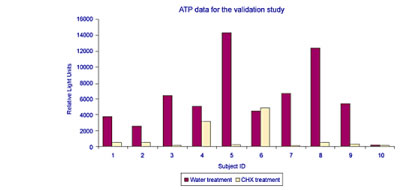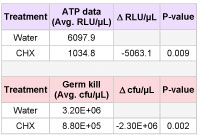ARTICLE: INFECTION CONTROL - HEALTHCARE - MEDICAL RESEARCH
ATP Bioluminescence: A Tool to Measure Clinical Efficacy of Topical Oral Anti-microbials
N. Ramji, R. Donovan-Brand, W. Buchanan, S. Hunter-Rinderle
Proctor & Gamble, Mason, OH, USA
ABSTRACT
Objective: ATP bioluminescence assay is routinely used for microbiology quality assurance purposes. It provides rapid quantification of bacteria in biological samples. The current study uses this system to quantify viable bacteria in gingival crevicular fluid (GCF). Methods: The test procedure starts with the selective extraction of non-microbial (somatic) ATP by a specific somatic cell extractant. The extractant makes the somatic cell membrane permeable for molecules like ATP. Microbial cells are not affected, because they have cell walls. The extracted somatic cell ATP is then hydrolyzed. Microbial ATP in the sample is then extracted and measured using a Luminometer after the addition of the reagent which contains Luciferase and Luciferin. The Relative Light Units (RLU) produced correlates with the amount of bacterial ATP in the sample. A pilot study with 10 subjects was designed to validate the application of this technique in measuring clinical efficacy of antimicrobials.
Changes in ATP bioluminescence and colony-forming units (cfu) of gram-negative anaerobes (GNA) from GCF samples were measured after 0.12% chlorhexidine (CHX) rinse. Overnight samples were collected from the subjects after three 15 mL CHX rinses for 30 seconds. Water was used as a control. Results: Analysis using paired-t test showed statistically significant reductions in bioluminescence (p=0.009) and cfu/mL (p=0.002) for the sub- gingival microorganisms after CHX treatment as compared to water control. The mean difference (Water minus Peridex) was 5063 RLU and 2.29x106 cfu/mL.
Conclusions:
ATP bioluminescence assay could be effectively used as a pharmacodynamic tool to
assess the clinical efficacy of dental products with antimicrobial activity.
INTRODUCTION
Bacterial metabolism requires ATP and this can be used as a measure of viable bacteria in biological samples. ATP bioluminescence is a sensitive technique, which detects bacteria by
measuring light emitted when their ATP reacts with firefly luciferase and luciferin. Standard microbiological techniques for culturing bacteria from samples take a minimum of 5 days to complete. ATP bioluminescence assay reduces this testing time to 24 hours and, in some cases, less than a minute for basic surface and liquid testing. The test procedure uses an industry-leading ATP assessment system which selectively extracts non-microbial (somatic) ATP
by a specific somatic cell extractant. The extractant makes the somatic cell membrane permeable for molecules like ATP, which leak out. Microbial cells were not affected. Extracted non-microbial ATP is next hydrolyzed using the extractant. Microbial ATP is measured in a Luminometer after addition of liquid reagents. The amount of light produced correlates with amount of ATP in the
sample, shown as Relative Light Units (RLU).
The light measurement is based on the following reaction:
Mg++ Luciferin+ Luciferase + ATP_ (Luciferin-Luciferase-AMP)+ Pyrophosphate O2 (Luciferin-Luciferase-AMP) _ Oxyluciferin + Luciferase + CO2+AMP + Light
The purpose of the current study was to quantify viable bacteria from GCF using the IMC kit and to evaluate the subgingival germ kill efficacy of a broad spectrum antimicrobial (often used as positive
control) like chlorhexidine gluconate (Peridex) using ATP measurements and plating techniques.
MATERIALS AND METHODS
Study Design:
This was an exploratory team test where a total of 10 subjects were evaluated for sub-gingival benefit after treatment with chlorhexidine gluconate. Prior to the study, subjects were charted to identify the sites for sample collection. Subjects were acclimatized on Crest Cavity Protection (CCP) toothpaste for 3 days and the morning of sample collection they came in un-brushed. The
first day subjects brushed with CCP for 1 minute followed by rinsing with 15mL water for 15 seconds. As a part of the water treatment, subjects rinsed with 15mL water for 30 seconds in the morning, afternoon and evening and abstained from eating or drinking for 30 minutes after each treatment. On the second day, subjects reported to the clinic unbrushed and GCF samples were collected to evaluate the efficacy of the water treatments on sub-gingival microorganisms. After sample collection, subjects once again brushed with CCP and rinsed with 15mL water for 15 seconds. This was followed by rinsing with 15 mL 0.2% chlorhexidine gluconate (CHX) for 30 seconds in the morning, afternoon and evening. On the third day subjects once again reported to the clinic unbrushed and the GCF samples were collected to evaluate the efficacy of the chlorhexidine treatments on sub-gingival microorganisms.
Sample collection:
Saliva and supra-gingival plaque were removed from the area around the GCF test sites. GCF sample was collected by inserting a strip of Periopaper (ORA Flow Inc., Babylon, NY) into the pocket of the sampling site in such a fashion that the apical end of the strip touched the deepest part of the midinterdental area. The strip was held for 30 seconds and the GCF collected was
immediately measured using a Periotron (Periotron 8000). Samples were collected from two sites, the two periostrips were pooled into a sample vial containing 1 milliliter Reduced Transport Fluid (RTF) and placed in ice. The volume of sample collected, as determined by the Periotron, was used for normalization of data obtained from ATP and germ kill analysis.
Sample processing:
A 1:100 and 1:1000 dilution of the GCF sample was cultured anaerobically on Enriched Tryptic Soya Agar containing Nalidixic acid and Vancomycin (ETSA-NV) for total gram negative anaerobes while the undiluted sample was analyzed for ATP bioluminescence.The colony counts on ETSA-NV were reported as colony forming units per milliliter (cfu/mL).
ATP Testing Results:
There was a significant positive correlation between the ATP data and germ kill for sub-gingival microorganisms after treatment with chlorhexidine gluconate treatment (CHX). Analysis using paired-t test showed statistically significant reductions in bioluminescence (p=0.009) and cfu/mL (p=0.002) for the sub-gingival microorganisms after CHX treatment as compared to water control. The mean difference (Water minus Peridex) was 5063 RLU and 2.29x106 cfu/mL. The was an exploratory team test and needs to be followed by a controlled clinical involving a strong/broad spectrum antimicrobial, as a part of the validation study (Table 1.).


Research presented at the 80th General Session of the IADR, March 6-9, 2002
CONCLUSION
ATP bioluminescence may be effectively used to quantify metabolically active/ viable microorganisms in clinical samples and this test procedure may be used as a pharmacodynamic tool to evaluate the clinical efficacy of dental products with antimicrobial activity.
Acknowledgments: Susan Moffa (Customer Service Manager-
Celsis Inc.), Brandon Peterson (Xavier University –Ohio).
Research presented at the 80th General Session of the IADR, March 6-9, 2002
Edited from Original Document by: BEM, Corp.
联系Hygiena技术支持小组, 请浏览我们的技术支持页面获得更详细信息或者Email给我们:support@hygienausa.com。
|